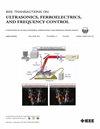用于原位肝脏模型的核磁共振成像共聚焦啮齿动物组织切片阵列
IF 3.7
2区 工程技术
Q1 ACOUSTICS
IEEE transactions on ultrasonics, ferroelectrics, and frequency control
Pub Date : 2025-03-20
DOI:10.1109/TUFFC.2025.3553083
引用次数: 0
摘要
组织切片术已经成为肝脏肿瘤的一种有前景的治疗选择,最近获得了FDA在2023年10月的临床应用批准。临床前体内组织切片实验主要利用皮下异位小鼠肿瘤模型,无法准确复制肝脏肿瘤的复杂免疫抑制肿瘤微环境(TME)。为了解决这一差距,我们提出了一种微型的、电子可操纵的mri引导的组织切片阵列的设计、开发和体内演示,该阵列专为原位小鼠肝脏肿瘤模型量身定制。这种新颖的系统在7.0T小动物MRI扫描仪中集成了89个单元相控阵,通过增强的软组织对比和三维可视化实现精确靶向。在模拟组织红细胞模型中验证了该阵列的靶向精度,其精度为0.24 mm±0.1 mm。随后的naïve小鼠体内实验显示肝脏消融成功,经大体形态学和组织学分析证实。然而,光栅瓣的存在导致了意想不到的附带损伤,尤其是肺部出血,这就需要未来对阵列的设计进行调整。本研究阐明了将组织切片实验从皮下移植到原位移植模型的基本步骤。本文章由计算机程序翻译,如有差异,请以英文原文为准。
MRI Coregistered Rodent Histotripsy Array for Orthotopic Liver Models
Histotripsy has emerged as a promising therapeutic option for liver tumors, recently gaining food and drug administration (FDA) approval for clinical use in October 2023. Preclinical in vivo histotripsy experiments primarily utilize subcutaneous ectopic murine tumor models, which fail to accurately replicate the complex immunosuppressive tumor microenvironment (TME) of liver tumors. In order to address this gap, we present the design, development, and in vivo demonstration of a miniature, electronically steerable magnetic resonance imaging (MRI)-guided histotripsy array tailored for orthotopic murine liver tumor models. This novel system integrates an 89-element phased array within a 7.0-T small animal MRI scanner, enabling precise targeting through enhanced soft tissue contrast and 3-D visualization. The targeting accuracy of the array was validated in tissue-mimicking red blood cell (RBC) phantoms, exhibiting targeting precision of $0.24~\pm ~0.1$ mm. Subsequent in vivo experiments in naïve mice demonstrated successful liver ablations, confirmed by gross morphology and histological analysis. However, the presence of grating lobes led to undesired collateral damage, highlighted by lung hemorrhages, necessitating future adjustments in the array’s design. This study illustrates the foundational steps necessary for translating histotripsy experiments from subcutaneous to orthotopic models.
求助全文
通过发布文献求助,成功后即可免费获取论文全文。
去求助
来源期刊
CiteScore
7.70
自引率
16.70%
发文量
583
审稿时长
4.5 months
期刊介绍:
IEEE Transactions on Ultrasonics, Ferroelectrics and Frequency Control includes the theory, technology, materials, and applications relating to: (1) the generation, transmission, and detection of ultrasonic waves and related phenomena; (2) medical ultrasound, including hyperthermia, bioeffects, tissue characterization and imaging; (3) ferroelectric, piezoelectric, and piezomagnetic materials, including crystals, polycrystalline solids, films, polymers, and composites; (4) frequency control, timing and time distribution, including crystal oscillators and other means of classical frequency control, and atomic, molecular and laser frequency control standards. Areas of interest range from fundamental studies to the design and/or applications of devices and systems.

 求助内容:
求助内容: 应助结果提醒方式:
应助结果提醒方式:


